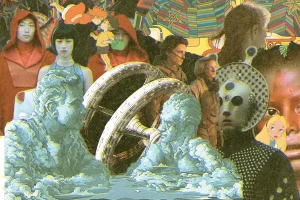Pop Art, a movement originating in the post-World War 2 United States and Britain, is known for its depictions of popular culture, including products as well as images from movies and TV. Andy Warhol is perhaps the most famous example, with his well-known paintings of Campbell’s Soup Cans and Marilyn Monroe. Another classic example is Roy Lichtenstein’s blown-up cartoons from comic strips.
While psychedelics were not a common influence behind early Pop Art, its bucking of art conventions and defamiliarization of everyday objects often gives it a psychedelic feel. And since then, some artists have created more explicitly psychedelic art that is heavily influenced by the Pop Art movement.
Meet the People by Eduardo Paolozzi (1948)

Scottish artist Eduardo Paolozzi created collages from American magazines. This 1948 piece represents themes of American consumerism and captures a moment in pop culture history, with a photo of Lucille Ball in the film Meet the People. Though this was made long before the hippie era, the rainbow background, orange juice, and colorful fruits give off presciently psychedelic vibes.
READ: The Best Psychedelic Albums Through the Ages
Love by Robert Indiana (1966–1999)

This iconic image first started as a Christmas card in 1964, then evolved into a painting and, finally, the sculpture many of us have seen today. The contrasting colors and simple message of love made it a favorite among hippies in the ’60s.
Album Cover for Sgt. Pepper’s Lonely Hearts Club Band by Peter Blake (1967)

Sir Peter Thomas Blake, known as the godfather of modern Pop Art, created two album designs for The Who as well as this famous one for The Beatles’ Sgt. Pepper’s Lonely Hearts Club Band. You can see the psychedelic influence in the bright-colored uniforms and flowers.
READ: The Best Movies to Watch on Psychedelics, Depending on Your Vibe
Rubber Pencil Devil by Alex da Corte (2018)

How can you make condiments, dice, and other everyday objects trippy? Make them look human. How can you then make these pop art motifs modern? Combine them into a film. The end product is two hours and 40 minutes of cartoon characters and people dressed as food. According to Yatzer, the film immerses “visitors in an over-sized and over-saturated universe of intellectually provocative, exuberant, and absurd fantasies that provide a critical take on contemporary reality.”
Fungi Bathing by Katherine Bernhardt (2022)

A cat reminiscent of the Pink Panther basks in what appears to be a shower full of mushrooms. A statement about the power of psychedelics to clean out the psyche, perhaps. Or just a cute character who we hope is not about to be poisoned by the shrooms.
Double Jane by Keiichi Tanaami (2014)

The jarring rainbow colors added to these old magazine covers give images traditionally catered to the male gaze a haunting, creepy quality. Tanaami is one of Japan’s most well-known pop artists, with work full of warped human figures and World War II-inspired imagery.

DoubleBlind is a trusted resource for news, evidence-based education, and reporting on psychedelics. We work with leading medical professionals, scientific researchers, journalists, mycologists, indigenous stewards, and cultural pioneers. Read about our editorial policy and fact-checking process here.

DoubleBlind Magazine does not encourage or condone any illegal activities, including but not limited to the use of illegal substances. We do not provide mental health, clinical, or medical services. We are not a substitute for medical, psychological, or psychiatric diagnosis, treatment, or advice. If you are in a crisis or if you or any other person may be in danger or experiencing a mental health emergency, immediately call 911 or your local emergency resources. If you are considering suicide, please call 988 to connect with the National Suicide Prevention Lifeline.





